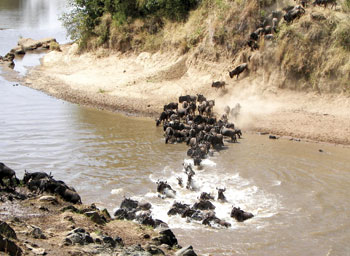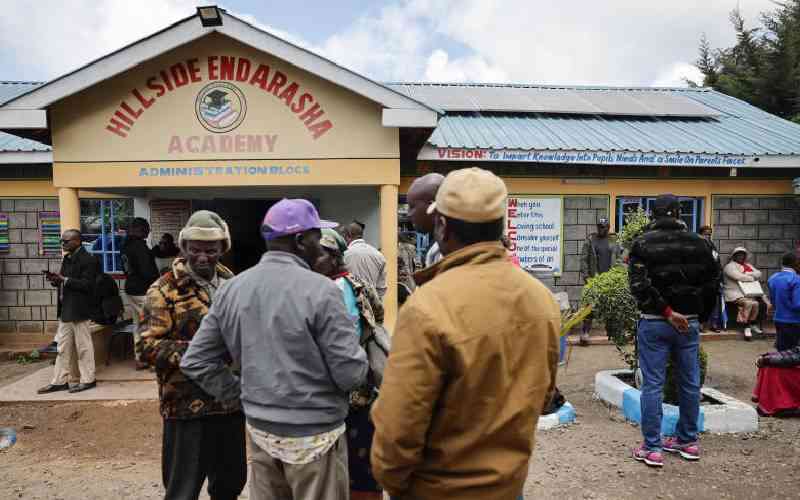Though he did not see the wildebeest migration, HAROLD AYODO was among many who turned up to wait for the mass movement of wild animals roaming free through unspoiled and savage wilderness.
Darkness covered the vast land when our plane touched down at Olkiombo airstrip in Masai Mara Game Reserve shortly after 11pm on Friday. Fourteen other planes landed in quick succession within the hour before we boarded a Land Cruiser to the Jonas Kristopher (JK) Camp where we checked in.
Most of the flights were either chartered or private with four passengers on board — including a tour guide.
Tropic Air, Air Kenya and Safari Link were among the commercial flights ferrying passengers from Wilson airport for the Mara excursion. At the airstrip, several Land Cruisers belonging to assorted lodges, cottages and camps parked, waiting to pick their clients.
The beehive activities were similar in Ngerende, Musiara, Kichwa Tembo and Keekorok airstrips in Masai Mara Game Reserve. Parents and children clad in shorts, jeans, T-shirts and sandals dragged their wheeled bags into waiting vehicles to their lodges.
Majority of the local and foreign tourists are trooping to Masai Mara for the Wildebeest migration spectacle — a wonder of the world. Nothing compares to the mass movement of wild animals roaming free through unspoiled and savage wilderness. Interestingly, game drives here start from the airstrip to the lodges as herds of wild animals are seen. There was a mini jam of Land Cruisers and tourist vans with open roofs from the airstrip through the dusty roads across the vast conservancy.
peak season
We saw several Masais clad in traditional regalia herding hundreds of cattle as Ben Leuka, our tour guide, explained that it was peak season in the Mara.
"Between July and October, wildebeest migrate to the Mara from Tanzania to graze. The mass of over two million wildebeest covers the savannah grasslands," Leuka said.
For starters, the wildebeest migration also known as ‘The Great Migration’ takes place between Masai Mara and Serengeti National Park in Tanzania. It is one of the greatest wildlife spectacles on the planet, as thousands of wildebeest and zebras migrate between the two conservation areas in search of fresh grazing. We watched as predators — lions, hyenas and cheetahs — closely followed the massive herds making the most of every opportunity to catch their next meal. Tourists unleashed their zoom cameras and clicked away at the marvel that has been named a new world wonder.
"Some tourists camp here inside their cars with packed food for hours awaiting the wildebeests crossing to either photograph or capture them on video," Leuka explained. Unfortunately for us, we could not afford such luxury of waiting for the wildebeests.
 |
The wildebeests cross the Mara River |
The precise timing of the annual spectacle depends on the rains, as it is an unpredictable and spontaneous natural event. Furthermore, the calving season takes place in the Serengeti between January and mid-March as the migration starts to head towards the western Serengeti in May or June.
the crossing
The best time to see the migration is between June and August when the wildebeest congregate and prepare to cross the famous Grumeti River. And if you are in the Masai Mara you can expect the wildebeest to make their arrival as early as July, but they generally arrive between August and September. The countless herds amass along the swollen Mara River — a final barrier from the short sweet grasses of the Masai Mara.
Stay informed. Subscribe to our newsletter
However, sometimes the crossing place they have chosen is shallow allowing the majority to pass safely but some drown, falling prey to slashing crocodiles. They remain in the Mara between October and November when they gradually begin their migration back towards the Serengeti.
In October, as the short rains begin to fall in the south and east of Serengeti, the herds start to leave the Mara, crossing Mara River again back to Tanzania. Flashback to throughout July; The herds cross the Sand River, a mostly dry tributary of the Mara, which roughly follows the boundary line between Kenya and Tanzania. The parade takes the eastern sector of Masai Mara, surrounding the Keekorok Lodge area.
The trek follows westward, leading the herds to face the major challenge along their quest — crossing the Mara River and frequently also its tributary, the Talek. By then, the rains at the Mau Escarpment, where the Mara River rises, have fed the stream to its highest levels.
full bookings
During the spectacle, lodges, cottages and tented camps at the Mara are fully booked with several tourists making early reservations. For instance, JK Camp manager Philip Leuka says their capacity of 28 clients is mainly on reservations.
"The peak seasons of the wildebeest migrations are our best in terms of accommodation with guests from all over the world," Philip says.
According to Philip, most guests arrive at the Olkiombo airstrip before they pick them up for a 30-minute drive to the camp.
"Game drive actually starts from the airstrip to the camp as Mara has a concentration of wildlife," Philip says.
big five
The Mara is not only about the wildebeest migration as the big five — lions, elephants, buffalos, leopards and rhinos — are here. Philip says they drive clients to the Mara River for a glimpse of the spectacle, which is a must see.
During our morning and evening game drives, I realised it’s easier to view game here, compared to some conservation areas countrywide, following their huge concentration.
Though we missed the migration, we feasted our eyes on other animals. However, the future of the wildebeest migration spectacle hangs in the balance following plans by Tanzania to put up a 480-kilometre highway through Serengeti National Park.
Environmentalists say the planned road, from Arusha across the Unesco-listed wildlife sanctuary to the shores of Lake Victoria, would devastate the ecosystem. The road would also disrupt the world famous wildlife migration and be a freeway for poachers.
It is feared the plan would greatly affect the Mara-Serengeti ecosystem, as wildebeests will be blocked from going into the Mara and back into Serengeti in search of pasture.
The planned road construction is likely to shake Kenya’s tourism industry, as it will disrupt the peak time of the wildebeest spectacle. Last year, reduction of water in River Mara, whose origin is in the Mau Forest, and which traverses the expansive Maasai Mara into Serengeti in Tanzania, threatened the spectacle.
Back to our Mara excursion, more private and chartered flights were touching down at Olkiombo airstrip as we prepared to board our 30-minute flight to Wilson Airport. Experiencing the migration spectacle needs time and above all patience.
 The Standard Group Plc is a
multi-media organization with investments in media platforms spanning newspaper
print operations, television, radio broadcasting, digital and online services. The
Standard Group is recognized as a leading multi-media house in Kenya with a key
influence in matters of national and international interest.
The Standard Group Plc is a
multi-media organization with investments in media platforms spanning newspaper
print operations, television, radio broadcasting, digital and online services. The
Standard Group is recognized as a leading multi-media house in Kenya with a key
influence in matters of national and international interest.
 The Standard Group Plc is a
multi-media organization with investments in media platforms spanning newspaper
print operations, television, radio broadcasting, digital and online services. The
Standard Group is recognized as a leading multi-media house in Kenya with a key
influence in matters of national and international interest.
The Standard Group Plc is a
multi-media organization with investments in media platforms spanning newspaper
print operations, television, radio broadcasting, digital and online services. The
Standard Group is recognized as a leading multi-media house in Kenya with a key
influence in matters of national and international interest.









